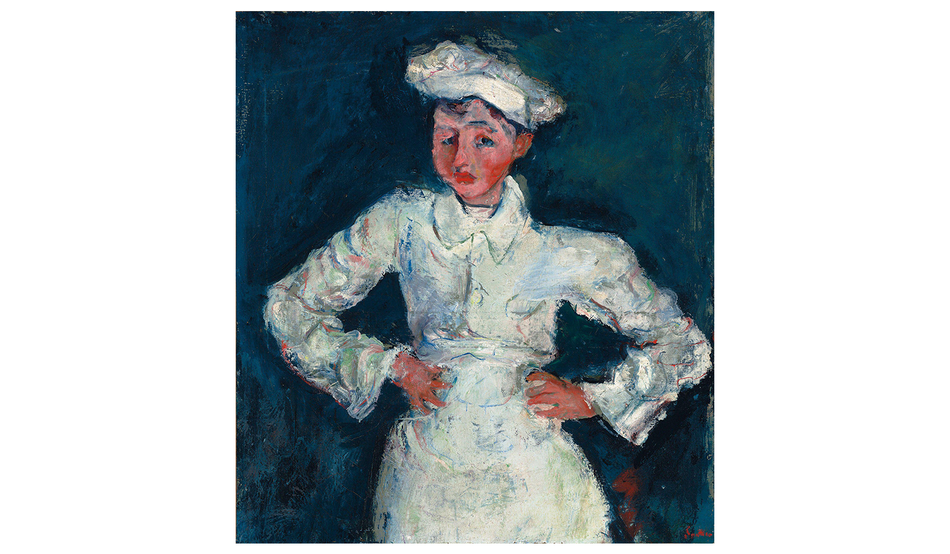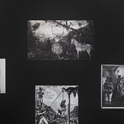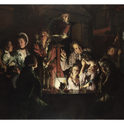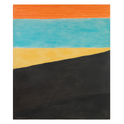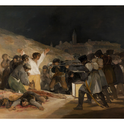Seeing Chaïm Soutine’s The Little Pastry Chef (circa 1927) for the first time did not just take my breath away, it knocked the air out of my body. Displayed alongside Leon Kossoff’s sculptural London landscapes, familiar in subject and style, the delicacy of Soutine’s portrait glued me to the spot at the Hastings Contemporary in 2023. In the figure of the young pastry chef, that mix of adolescence’s bottomless insecurity and flashes of swagger came flooding back, felling every onlooker—or at least this one—at the knees.
White is a perennial challenge for artists, but in this work Soutine has taken it up with admirable sophistication. He renders the chef’s whites like marble, with veins of green highlighting the jacket collar and hat brim, while the draping and creasing of the sleeve almost lift off the canvas in solid swirls of peach, pistachio and ice blue. The figure’s ear and nose are less exaggerated and more lifelike than in many of Soutine’s other portraits, and his shoulders do not slope, squaring up to the viewer in a pose of concentrated energy and vitality. In his oversized, double-breasted chef’s jacket, the man-boy’s work clothes are too big, but still he is trying to fill them. His struggle to fulfil the responsibilities of adulthood when he is barely ready is a familiar one.
The array of liveried hotel staff presented Soutine with a pageant of costumes and colour. Throughout the 1920s, he painted at least 30 portraits like The Little Pastry Chef of a hotel’s workforce: not only chefs but waiters, bellhops and chambermaids, all of them in France. He had first arrived in Paris in 1913 at the age of 20, fresh from his studies in Vilnius. Reminiscent of his impoverished childhood in a Belarussian shtetl, his formative years in the French capital were largely hand to mouth. Eventually he came to rely on a tiny allowance of five francs a day from his art dealer Léopold Zborowski, but on the condition he leave Paris for a period and live in the Pyrenean village of Céret. Unable to pay for models, he began to paint ordinary working people instead.
It was an earlier depiction of another chef, painted in about 1919—now known as The Pastry Chef (Baker Boy)—that became a turning point in Soutine’s career. At some point in 1922 it was spotted by the American collector Albert C Barnes, who is said to have exclaimed, “It’s a peach!” before buying it and 51 other works on the spot.
From that point onwards, Soutine’s financial situation improved, allowing him to stay for longer stretches in the Parisian hotels that employed his favourite sitters. As such, the emotional power of this particular chef, his sixth and final version, is more complex than just one patronage-dependant worker showing empathy for another.
Having studied and copied the Old Masters in the Louvre, Soutine has imbued this last chef with inherent worth by employing the techniques of grand portraiture: a single figure against a solid but unspecific background, in the tradition of Renaissance portraits of princes and kings; the chef’s power pose, hands on hips and looking directly at the viewer, alludes to Holbein’s portrait of Henry VIII. And the young worker’s flattened, slightly diagonal torque blanche (chef’s hat) echoes Rembrandt’s headgear in self-portraiture. Yet the overall effect is unsettling. “One aspect of this is the way sitters try so earnestly to belong to a tradition that was so clearly not created for them,” as writes Barnaby Wright, deputy head of the Courtauld Gallery. “This does not just inspire pity, it destabilises the genre.”
Only one of Soutine’s sitters—the 17-year-old Céret chef Rémy Zocchetto, from The Pastry Cook (1919)—has ever been identified. But there is no doubt that this 1927 portrait is likewise a real individual. At the same time the work is a character study of a new class of urban worker supporting the leisure industry, a hallmark of the Roaring Twenties which today recalls the labourers behind our own holidays.
Soutine’s ability to capture individual and social turbulence within his hugely varied brushstrokes has come to embody all his work. In 1993, The Little Pastry Chef was chosen as one of the covers for his catalogue raisonné; in 2013, it set a world auction record for the artist when it sold for over $18m at Christie’s in New York. The painting is currently on loan to the National Gallery, where it sits in Room 45—devoted to “New Energies: Painting around 1900”.
